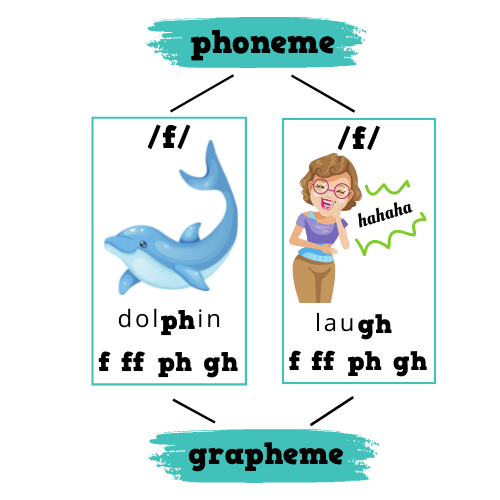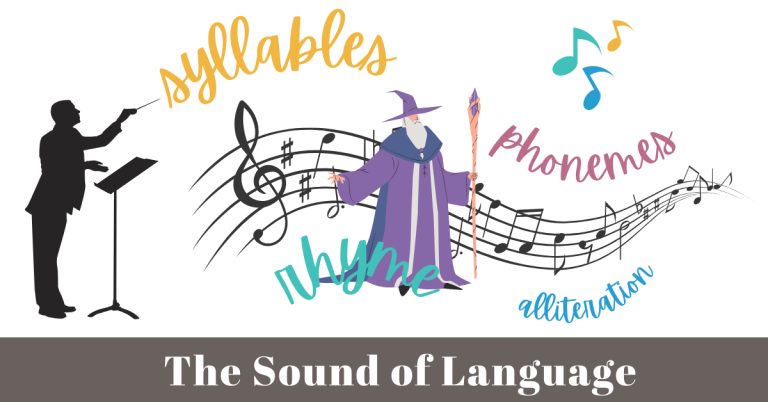Ways to Teach Phoneme Manipulation Skills to Kids
Playing with sounds within words to create new words and sounds is fun! Although phoneme manipulation can be tricky to learn, it’s an immensely beneficial skill when it comes to reading and spelling.

Don’t sweat it if you haven’t heard the term phoneme manipulation before, it simply refers to the more advanced skills of phonemic awareness.
Phonemic awareness contains six layers that build from the simplest phonemic awareness skills at the bottom to the more complex phonemic tasks at the top. In the early years, these skills can be learned and practiced through oral wordplay and rhymes, read-alouds, story extensions, literacy games, and other fun early literacy activities.

The beginning levels of phonemic awareness involve isolating, segmenting, and blending phonemes. These are essential for learning to read and write. Read our post about these beginning-level phonemic skills explaining how to teach isolating, segmenting, and blending phonemes and ways you can help your child or student practice these important skills.
The top three layers are what make up the more advanced levels of phonemic awareness and involve, adding, deleting, and substituting phonemes, explained with examples further down in this post.
Don’t get bogged down by all the terms. It can sometimes be tough to keep them all straight, but if you keep reading, you’ll see that it is not quite as complicated as it all sounds.
What is Phoneme Manipulation?
Phoneme manipulation is the act of rearranging or changing individual sounds (phonemes) in a word to create new words (real or made-up). This can be done by adding, deleting, or substituting phonemes. A simple example is changing the /a/ phoneme in the consonant-vowel-consonant word (CVC word) ‘fan’ to a /u/ phoneme sound to create the word ‘fun’.
Phoneme manipulation is an advanced phonemic awareness skill and falls under the larger umbrella of phonological awareness.
Children learn to add, delete, and substitute phonemes starting with words containing 2-3 phoneme sounds typically matching the letter count of the word. As they develop their language and literacy skills, the difficulty of these phoneme manipulation tasks can be increased.
The more complex levels of phoneme manipulation are not typically mastered until the end of grade three.
What are Examples of the Different Types of Phoneme Manipulation?
There are three types of phoneme manipulation: phoneme deletion, addition, and substitution.
- Adding Phonemes: the process of making new words or sounds by adding a phoneme to an existing word or group of phoneme sounds.
- Deleting Phonemes: the process of making new words or sounds by removing a phoneme from an existing word or group of phoneme sounds.
- Substituting Phonemes: the process of making new words or sounds by changing out a phoneme n a word or group of phoneme sounds and replacing it with another one.
Phoneme substitution is the most difficult type of phoneme manipulation and puts a higher demand on working memory.
Working memory helps kids hold on to information long enough to use it. Poor working memory affects a variety of other skills including reading, language comprehension, and math. Working memory also plays an important role in concentration and in being able to follow more than one set of instructions.

Why is Phoneme Manipulation Important for Reading?
To understand why phoneme manipulation is important for learning to read, we need to understand a little about what makes a fluent reader.
Fluency, alongside accuracy and speed, is an important marker for what determines how well someone can read – or at least apply their knowledge of letter-sound relationships to correctly pronounce written words (decode).
When children pick up on sound patterns and have good phonemic awareness, they are better equipped for when it comes time to learning the process of decoding words and figuring out unknown words as they increase in their level of reading.
For example, let’s say a child who knows the word ‘beak’ later comes across the word ‘bleak’ which is unfamiliar to him/her. To figure out how to pronounce this word, he/she can use their knowledge of the word ‘beak’ and known words that contain /bl/ sound at the beginning, such as ‘blast’ and ‘blocks’, and put this knowledge together to know how the addition of an /l/ sound after the initial consonant (/b/) will change the pronunciation of ‘beak’ to form ‘bleak’.

Practicing phoneme segmenting and blending activities also helps build fluency with reading and build children’s ability to hear the phoneme sounds in words or to hear the actual word the phoneme sounds create when combined.
When you are a fluent reader, you recognize a high percentage of words in a text instantly and effortlessly by sight. Letter-sound patterns and whole words become orthographically mapped in your brain and you do not need to labourously decode words by each individual sound (phoneme by phoneme).
To be a strong reader, you also need good reading comprehension skills. And a child’s comprehension skills are affected by their ability to decode. If a child really struggles with decoding, their working memory is extremely taxed in trying to decode that often trying to also make sense of what the text is saying leads to cognitive overload.
A child’s exposure and knowledge of language and speech sounds immensely influences their ability to make the transition into reading printed text, with phoneme manipulation being a key marker for predicting reading proficiency.
The Dynamic Duo

Help your little learner by using visual aids to discern the beginning, middle, or end sounds in words. Simple draw out boxes, and use manipulatives, in the style of Elkonin boxes.
Want to get more creative – click to discover lots of great ideas for tools for phonemic awareness tasks to keep your little learner enthusiastically engaged!


Phonemic awareness forms the foundation of literacy, and it’s okay if some children need more time to grasp it. Tailor your activities to your child or student’s developmental level and progress gradually as their skills improve. Remember, small steps count! There is a lot of joy and power through positive reinforcement by celebrating small achievements along the way.
When Should Phonemic Manipulation be Mastered?
The ability to manipulate phonemes is typically mastered by end of grade three and for some a little into grade four.
While many children may naturally learn these advanced phonemic skills and orthographically map words as they progress with their reading and studies, children who have reading struggles, disorders, and poor phonological and phonemic awareness can immensely benefit from having these skills explicitly taught through a systematic and cumulative approach.
Before going into detail about the three types of phoneme manipulation and fun activities to help children practice these skills, let’s briefly cover what a phoneme and grapheme are to avoid confusion.
What are examples of phonemes?
Phonemes make up the smallest unit of sound in a spoken language. Words are made up of different phoneme combinations/sound patterns.
Phonemes can be chunked together in different ways to help break words apart, making them easier to learn, such as syllables and onset-rime patterns.
The English alphabet is made up of 26 letters that create 44 phonemic speech sounds, each with a universal written symbol. These sounds have been combined to create thousands of English words.
Phonemes can be made up of one or more letters. Take the following three words ‘car’, ‘chat’, and ‘cheat’ for example. All three of these words contain three phonemes but have different amounts of letters.
- The word ‘car’ has three letters and three phonemes:
/k/ /a/ /r/ - The word ‘chat’ has four letters but only three phonemes: /ch/ /a/ /t/
- The word ‘chain’ has five letters but again only three phonemes: /ch/ /ea/ /t/

What are examples of graphemes?
The above example naturally leads us into understanding that individual alphabetic letters or groupings of letters represent speech sounds (phonemes). These written representations of phonemes are called graphemes.
This is where it gets interesting because there can be many different graphemes for one phoneme (or to put it differently, graphemes can represent more than one phonemic sound). There are over 200 graphemes in the English language.
Take, for example, the /c/ sound in the word cat which sounds like a /k/, and compare it with the /c/ sound in the word city which sounds like a /s/.
A more complex example is comparing the sound /ai/ makes in the word ‘rain’ to this same sound represented by different graphemes in the words reign, freight, straight, late, they, say, and steak. Understanding how there can be many graphemes for one phoneme sound, only emphasizes how important it is for children to be exposed to sound patterns and the ability to isolate sounds within their spoken language(s).
Phoneme Manipulation Continuum
The skills of adding, deleting, and substituting phonemes in words each have their own continuum of complexity. These tasks can also be made additionally challenging by combining manipulation tasks together.
To illustrate this point, let’s compare a simple deletion task to a more complex task that involves deletion and substitution:
Simple Deletion Task: remove the /l/ sound from the word ‘clap’, what new word does this create?
Answer: cap
NOTE: an even simpler deletion task would be to remove the /c/ sound from the word ‘clap’ to be left with the word ‘lap’. Deleting the beginning sounds of a word is an easier task than deleting a middle sound.
Complex Deletion and Substitution Task: remove the /ai/ from the word ‘chain’ and substitute /i/ instead. What new word does this create?
Answer: chin
It’s best to do these exercises orally. When children are able to do phoneme manipulation tasks orally, perhaps with visual aids like Elkonon boxes to help them visualize phoneme positions, they can be given phoneme manipulation tasks that may also involve printed text.
As children develop and their language and literacy abilities improve, they can be asked to do more complex forms of phoneme manipulation tasks, such as working with more challenging phoneme sounds and combining manipulation tasks together.
The continuum of complexion with phoneme manipulation tasks is best illustrated through the word chain below. Follow along with the changes at each step and notice how the phoneme task increases in difficulty by placement and type of phoneme being manipulated, as well as, vocabulary choice and combination of tasks involved.

Looking for more examples? Use this excellent resource for word chain phoneme manipulation examples that have been sectioned into various categories such as CVC words, initial blends, long and short vowels, and more.
How do You Practice Phoneme Manipulation?
Phonemic awareness tasks involve listening and speaking… and playing with sounds to make new words or new sounds. When you throw in a little enthusiasm, children discover it’s fun to make new words!
Whether attempting an adding, deleting, or substituting task the same formula for how you want to approach each one is the same.
Approach For Younger Children When Introducing Phoneme Manipulation
Use the “I do, we do, you do” model
Keep these exercises oral, do not combine tasks at the same time, and only change one sound at a time.
Start with three-letter CVC, CCV, VCC, and CVV words
Order of Placement
- Start with the initial sound first
- Second, move to the final sound
- Finally, try the middle sound(s)
Order of Tasks
- Start with deletion tasks
- Second, move to addition tasks
- Try substitution tasks
Repeat this process using words that are 3, 4, and 5 sounds long. Add in more sounds when your child or student shows signs they are ready for the additional challenge. It is best to keep the pace slower and take your time with increasing the level of difficulty with phoneme manipulation tasks.
When introducing phoneme manipulation, start with single-letter sounds, meaning they contain the same number of letters and phonemes. Avoid words with diphthongs and digraphs until this step has been mastered.
Click to be taken up to the previous graphic illustrating the relationship difference between phonemes and letters (graphemes).
Approach for Older Children When Introducing Phoneme Manipulation
Use the “I do, we do, you do” model
Practice these tasks orally first. After this printed text and writing tasks can be added in as desired.
Start with four-five sounds in a word, it is easiest to start with single-letter sounds and avoid diphthongs and diagraphs at first.
Order of Placement
- Start with the initial sound first
- Second, move to the final sound
- Finally, try the middle sound(s)
Order of Tasks
- Start with deletion tasks
- Move to addition tasks
- Try substitution tasks
- Attempt combined manipulation tasks
Repeat this process by adding in more challenging phoneme sounds, like initial blends, diphthongs, long and short vowels, and digraphs.
Strong phonemic awareness skills are part of the broader skills of phonological awareness and are highly associated with better decoding skills and reading and spelling skills overall.
Just 10-15 minutes a day of engaging in intentional wordplay, including phoneme manipulation tasks, is all that is needed to build lasting positive impacts on young children’s literacy journeys.
To conclude this post, here are some tips you can refer back to when teaching phoneme manipulation to your child or student.
Key OOLiteracy Phoneme Manipulation Tips & Tricks


I’m happy you’re here!
Hi, I’m Julie, the passionate creator of Ox & Owl Literacy. I enjoy empowering families and educators with wonderful resources to inspire fun, imaginative, and joyful learning opportunities for young kiddos. You’ll find lots of recommended books, reading resources, and creative learning activities on this site aiming to help children fall in love with language, books, reading, and the transformational power of stories.














